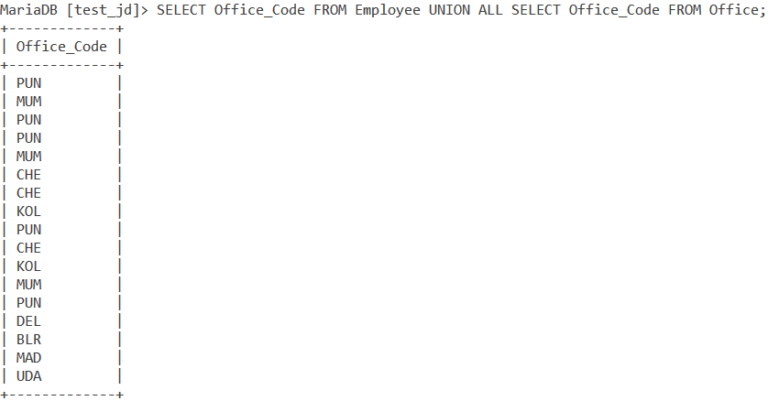
Where (ct.PartitionKey>=55 AND ct.PartitionKey= ' 17:00:00'Īnd ct.TxnCompleteTime =55 AND ct.PartitionKey= ' 17:00:00'Īnd ct.TxnCompleteTime =55 AND ct.PartitionKey= ' 17:00:00' and ct.TxnCompleteTime =55 AND ct.PartitionKey= ' 17:00:00' and ct.TxnCompleteTime <= ' 17:00:00') and ct. Left outer join AdditionalTxnInfo addti ON (ct.Id = addti.TxnId) Left outer join Merchant mc ON (ct.MerchantId = mc.Id) Left outer join ItemDispute id ON (ct.Id = id.TxnId and ci.Id = id.ItemId ) Left outer join CompleteItem ci ON (ct.Id = ci.TxnId) I don't see much difference between UNION ALL and UNION ALL - ORDER BYĭuration/Fetch Time: 2.182 sec / 1.513 sec SELECT col1, col2. Is it possible to create view from 3 queries without UNION ALL ?įollowing are the Individual and union queries tested from workbench. If I execute the whole query (3 subqueries with UNION ALL), it is taking more than 5 minutes. If I execute each subquery, getting the result in 1 or 2 seconds. I am using UNION ALL to combine the result from all tables. I need to combine all the data from these 3 tables and sort them by CreatedDate to display in my portal. Each table is having more than 2 million records.

And to combine the results, we are using the UNION ALL operator between the SELECT statements.I have 3 tables (SuccessOrder, FailedOrder, and PendingOrder) with same columns.

Moreover, we are also using a WHERE clause with each SELECT statement to fetch records where the country is Canada. And in the definition, we are using 2 SELECT statements to fetch the name, city, and country columns from respective tables. In the above example, we have created a view with the name CityView_CA. SELECT Name, City, Country FROM dbo.Customers_2 SELECT Name, City, Country FROM dbo.Customers_1 But, with the help of the UNION ALL operator, we can even combine duplicate entries of multiple SELECT statements within a single view.

Generally, a simple view in SQL Server includes the use of a single select statement. Similar to UNION operator in a SQL Server VIEW, using UNION ALL is also quite simple.
#Mysql union in view how to
Now that we have a clear idea of how to use the UNION operator in a SQL Server View, let’s understand how to use the UNION ALL operator in a view. UNION combines the result from multiple SELECT statements into a single result set. Read How to view table in SQL Server How to use union all in view SQL Server So, the view will return the distinct city names from both the tables that come under the United States. Moreover, we are also using a WHERE clause with each SELECT statement to fetch records where the country is the United States. And in the definition, we are using 2 SELECT statements to fetch the city and country columns from respective tables. In the above example, we have created a view with the name US_CityView. SELECT City, Country FROM dbo.Customers_2 SELECT City, Country FROM dbo.Customers_1 And again for this example, we will use the same tables illustrated in the previous section. Let’s understand the whole implementation using an example. But, with the help of the UNION operator, we can combine the results of multiple SELECT statements within a single view. So, using a UNION operator in a SQL Server VIEW is quite simple. Now that we have a clear idea about the use of the UNION operator, let’s understand how to use it in a view in SQL Server. Read SQL Server view order by How to use union in view SQL Server Now, from the above outputs, we can easily understand the difference between UNION and UNION ALL operators. Let’s understand the syntax of using the UNION and UNION ALL operator in SQL Server. A UNION operator in SQL Server does not include duplicate entries, while the UNION ALL operator includes duplicates in the result. Now, there is a slight difference between a UNION and a UNION ALL operator in SQL Server. As the name specifies, the main aim of the UNION operator is to perform the UNION operation. In SQL Server, the UNION operator is used to perform a set operation of combining the results of multiple SELECT queries. Read Create a table from view in SQL Server Union & Union All in SQL Server Moreover, we can also specify any sort of condition with the SELECT statement.

In this section, we will only cover the syntax of creating a view in SQL Server. For more information, refer to “ View in SQL Server“. A view includes a set of SQL queries for retrieving data from the database. In SQL Server, a VIEW is just like a virtual table that holds data from one or more than one table. How to use union all in view SQL Server.


 0 kommentar(er)
0 kommentar(er)
